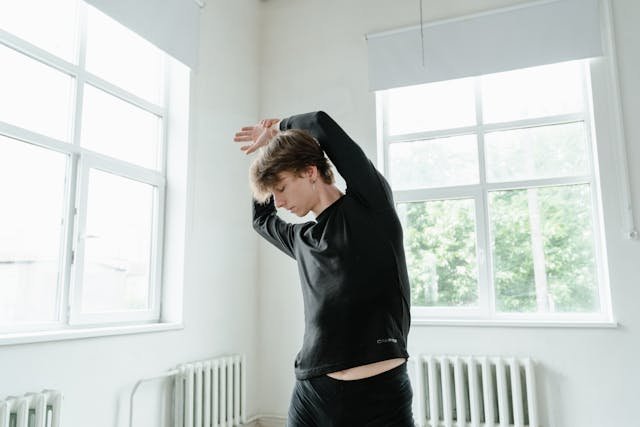Eustachian Tube Dysfunction (ETD) occurs when the eustachian tubes, which help regulate pressure and drain fluid from the middle ear, don’t work properly. The eustachian tubes can become blocked or fail to open properly, leading to symptoms like ear pressure, pain, muffled hearing, and discomfort.
While ETD is typically associated with colds, sinus infections, or allergies, there’s growing interest in understanding whether lifting heavy weights above the shoulders can contribute to ETD. This article explores the possible connection between heavy lifting and ETD, the symptoms, and what to do if you experience them.
How Lifting Heavy Weights Affect the Eustachian Tubes?
When lifting heavy weights, particularly during exercises like overhead presses or shoulder presses, pressure in the upper body and head increases significantly. This is due to a phenomenon called intra-thoracic pressure, which occurs when you hold your breath and strain to push weights upward. This pressure can momentarily impact how the eustachian tubes function.
For some people, especially those with preexisting issues like sinus congestion, allergies, or eustachian tube blockage, this increased pressure can aggravate their condition. Holding your breath during heavy lifts also mimics the Valsalva maneuver—a technique often used to equalize ear pressure—which can temporarily disrupt the eustachian tube’s function.
Symptoms of ETD Triggered by Lifting:
If lifting weights is affecting your eustachian tubes, you may notice:
- Ear pain or pressure: A feeling of fullness or discomfort in one or both ears.
- Muffled hearing: Sound may seem distant or muffled due to pressure imbalances in the middle ear.
- Popping or clicking sounds: As the tubes try to open and equalize pressure.
- Dizziness or vertigo: Some people may experience dizziness, which can be dangerous when handling heavy weights.
Can Heavy Weightlifting Cause ETD?
No! There is no direct scientific evidence linking weightlifting to the onset of ETD but the mechanics of heavy lifting above the shoulders could temporarily impact the eustachian tubes. In particular, people who frequently experience ear pressure, or those with narrow or inflamed eustachian tubes, may be at greater risk for developing temporary ETD-like symptoms after intense lifting.
Factors that might increase the likelihood of experiencing ETD during weightlifting include:
- Improper breathing technique: Holding your breath during lifts increases pressure in the head and can trigger ETD symptoms.
- Pre-existing sinus or ear conditions: If you have allergies, congestion, or inflammation in the ear, you are more likely to develop ETD during weightlifting.
- High-intensity exercises: Heavy, overhead exercises create greater intra-thoracic pressure, putting more strain on the eustachian tubes.
What to Do if You Experience ETD Symptoms While Weightlifting?
If you suspect that lifting weights is triggering ETD symptoms, here are a few steps to alleviate or prevent discomfort:
- Adjust your breathing technique: Avoid holding your breath during lifts, and focus on controlled breathing. Breathe out during the exertion phase of the lift to prevent excessive pressure buildup.
- Use lighter weights: If heavy weights exacerbate your symptoms, consider lowering the weight and gradually increasing your load over time.
- Avoid high-pressure exercises: Reduce or eliminate exercises that require overhead lifting, or modify your workout routine to reduce strain on the head and neck.
- Treat underlying conditions: If allergies, colds, or sinus infections are contributing to your ETD, treating these conditions with medication or nasal sprays can help.
- Consult a healthcare provider: If symptoms persist or worsen, it’s best to see a doctor or an ENT (ear, nose, and throat) specialist to assess your condition.
How to Prevent ETD During Workouts?
Here are some preventive measures to help avoid Eustachian Tube Dysfunction (ETD) while weightlifting:
1. Breathing Technique:

Avoid holding your breath during weightlifting, especially during the exertion phase of overhead lifts. Instead, practice controlled breathing: exhale as you lift the weight and inhale as you lower it. This reduces the buildup of pressure in the chest and head, which can affect the eustachian tubes.
2. Avoid Overexertion:
- Lifting excessively heavy weights can cause a sudden spike in intra-thoracic pressure, which may lead to ETD symptoms. Opt for moderate weights and increase your load gradually to prevent straining.
3. Posture and Technique:

Ensure your posture and lifting technique are correct. Poor form, especially during overhead movements, can put additional strain on your neck and upper body, increasing the likelihood of triggering ETD.
4. Stay Hydrated:
Dehydration can cause thickening of mucus, which can block the eustachian tubes. Stay well-hydrated to prevent congestion, especially if you’re working out in a hot or dry environment.
5. Treat Nasal Congestion:
If you suffer from allergies, sinus congestion, or colds, consider using a nasal decongestant or saline spray before workouts to ensure the eustachian tubes are clear.
6. Warm-Up and Cool-Down:
A proper warm-up and cool-down routine helps in gradually increasing and decreasing blood flow and pressure, reducing the strain on the head and neck.
7. Avoid Sudden Head Movements:
Rapid or jerky movements during weightlifting can increase pressure in the ears and disrupt the function of the eustachian tubes. Focus on smooth, controlled motions.
By adopting these strategies, you can reduce the risk of experiencing ETD symptoms while engaging in weightlifting, particularly with heavy overhead exercises.
Conclusion:
While there is no direct evidence that lifting heavy weights causes ETD, the increased intra-thoracic pressure associated with lifting overhead can potentially aggravate eustachian tube dysfunction symptoms. People with preexisting sinus or ear issues should be cautious and adjust their technique or avoid certain exercises. If you experience consistent symptoms, consult a healthcare provider to rule out other causes of ETD and receive appropriate treatment.
